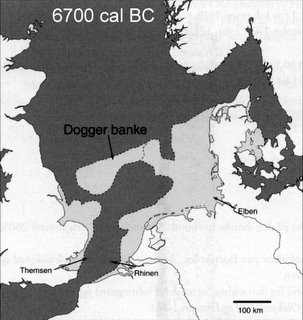Deluged hunting grounds
During the last Ice Age, so much of the world's sea water was bound up in glaciers that you could walk a straight line from Sweden to Scotland. Dogger Bank was a forest. The English Channel was a boggy valley.
The time between the end of the Ice Age and the adoption of agriculture in Northern Europe is called the Mesolithic, that is, the Middle Stone Age. It lasted for five thousand years, and a lot of its archaeology is now on the bottom of the North Sea. This means that when we dig Mesolithic sites on dry land, we can only study what people did when visiting the highlands of their day. If, for instance, we want to know what life was like around the mouth of the Thames in 7000 BC, we need diving suits.

Søren H. Andersen has a good little paper about this in the recently published issue for 2005 of Kuml, annual of the Archaeological Society of Jutland. He presents a pressure flaker fished out of the North Sea in 1989 by the crew of a trawler on Dogger Bank. A pressure flaker is a tool used to produce tiny flint blades, microliths, that were affixed to arrows or bone spear heads. This flaker is made of red deer antler with a radiocarbon date in the interval 7040-6700 BC, the late Maglemosian.
I find this instructive. Nothing is constant. An area larger than Holland and Denmark, home to hundreds of bands of Mesolithic people, a vast cultural landscape with place names, legends, oral history, camps tracks hearths tents graves, is now under tens of metres of icy brine, habitat for cod and whiting. And it isn't even anybody's fault. The sea just rose, slowly and steadily.
As H.P. Lovecraft so cozily put it,
The time between the end of the Ice Age and the adoption of agriculture in Northern Europe is called the Mesolithic, that is, the Middle Stone Age. It lasted for five thousand years, and a lot of its archaeology is now on the bottom of the North Sea. This means that when we dig Mesolithic sites on dry land, we can only study what people did when visiting the highlands of their day. If, for instance, we want to know what life was like around the mouth of the Thames in 7000 BC, we need diving suits.

Søren H. Andersen has a good little paper about this in the recently published issue for 2005 of Kuml, annual of the Archaeological Society of Jutland. He presents a pressure flaker fished out of the North Sea in 1989 by the crew of a trawler on Dogger Bank. A pressure flaker is a tool used to produce tiny flint blades, microliths, that were affixed to arrows or bone spear heads. This flaker is made of red deer antler with a radiocarbon date in the interval 7040-6700 BC, the late Maglemosian.
I find this instructive. Nothing is constant. An area larger than Holland and Denmark, home to hundreds of bands of Mesolithic people, a vast cultural landscape with place names, legends, oral history, camps tracks hearths tents graves, is now under tens of metres of icy brine, habitat for cod and whiting. And it isn't even anybody's fault. The sea just rose, slowly and steadily.
As H.P. Lovecraft so cozily put it,
Then, crushing what he chanced to mould in play,[More blog entries about archaeology, mesolithic, Denmark, Britain, North Sea; arkeologi, mesolitikum, Danmark, Storbritannien, Nordsjön.]
The idiot Chaos blew Earth's dust away.



7 Comments:
Hooray!
O frabjous day! Callooh! Callay!
I have always wondered what the low water levels means for the early city states? Don't we believe that the earliest cities/cultures where Indus and Mesopatamia? What if these where just colonies of a real high culture on the plain of what is now sea bed? Atlantis indeed....
Judging from the stuff the fishers trawl up from Dogger Bank and surrounding Mesolithic land areas, the people there were simple savages, to use a non-PC term. (And the funny "giant staircase" off the Bahamas is just geology.)
The first city states arose in areas where agriculture had already been adopted. The Atlantic fringe was very far in time and space from that.
Sorry -- Atlantis, Lemuria and Mu belong with the little green men and Elvis still being alive.
It's true the North Sea is a long way from the origins of agriculture, but I wonder what underwater archeology in the Persian Gulf or the Yellow Sea would reveal.
I don't know if there are any large shallow areas in the Yellow Sea. As for the Persian Gulf, the situation is the opposite of that in the North Sea. The Gulf used to reach much farther into Mesopotamia in the Bronze Age, so the ancient seabed is now dry land there.
... he chortled in his joy ...
Post a Comment
<< Home